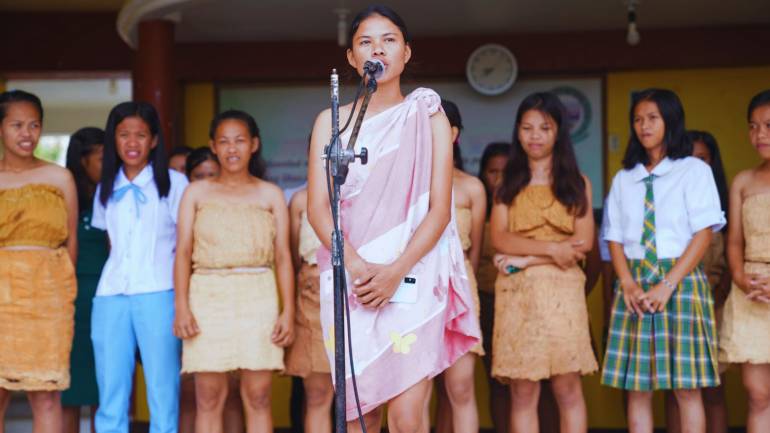Philippines: Indigenous Mangyan youth enjoy fruits of mission through education

98 indigenous Mangyan college students have been named scholars of the local government in Sablayan, Occidental Mindoro province, Philippines, in order "to serve as inspiration to others," said Walter 'Bong' Marquez, the chief executive.
Located at the heart of the Occidental Mindoro province, Sablayan is the largest municipality in the country in terms of land area, at 2,188.80 square kilometers.
Among the scholars is Tau-Buid Mangyan Daylyn Ragurayon, in her fourth year at Occidental Mindoro State College, taking up a Bachelor of Science and Information Technology.
On November 14, on the occasion of the 73rd founding anniversary of the province where the Society of the Divine Word has been doing mission, the Municipality of Sablayan inaugurated the Indigenous People’s (IP) dormitory in Sitio (sub-village) Macambang, in Barangay (village) Buenavista
"It is a symbol of paying homage to our first inhabitants, the Tao-Buid and Alangan Mangyans, and recognizing their participation in the progress and development of Sablayan, by giving their children a decent dormitory right near the colleges where they are enrolled," said Mayor Marquez.
"We pay tribute to them by keeping their children at bay with mainstream education responding to the call of the modern time while keeping their culture and tradition intact," he said.
Marquez added, "It shall serve as an educational and learning hub and hall of residence for the Mangyan students, including those who momentarily served as little government officials last October.”
During the Philippines’ National Indigenous Peoples' Month last month, Marquez said, “We promote awareness and appreciation of the IP’s rich cultural heritage and history.”
On October 23, during the “flag raising ceremony," selected Mangyan female students formally took their oath as “Little Officials” of Sablayan.
To maximize the event, the local government included non-Mangyan girls, with the United Nations General Assembly declaring October 11 as the International Day of the Girl since December 19, 2011.
“It is to recognize girls' rights and the unique challenges girls face around the world, which Mangyan girls also experience,” said Novio.
"...So, this is an all-girl affair. The main initiators are the MSWDO, Plan International, and the whole municipality of Sablayan. No national agency tried to get involved, not even the National Commission for the Indigenous Peoples,” said Novio.
Among the advocacies both Mangyan and non-Mangyan girls rally for are the fight against different forms of bullying, the campaign against early marriage, love and protection of the environment, education for all, and access to services, programs, and projects of the government.
For two days, they were made the counterparts of the mayor, vice mayor, members of Sangguniang Bayan, and heads of the departments and divisions.
Marquez tapped the Municipal Social Welfare and Development Office (MSWDO) to help choose the little officials and department heads from the Mangyan tribes in Sablayan.
The “little officials” were given gifts like school supplies and an amount of money solicited from the employees of the offices they were temporarily assigned.
In their exposure to local government work, the Mangyan girls were also happy to know about the “jungle wedding” for 18 Mangyan couples at Sitio (sub-village) Kimali, Barangay (village) San Agustin, held on October 19.
The supervising staff from the offices of the civil registrar and of the chief executive had to walk for five to six hours and cross several mountains and rivers.
They also brought the National Task Force to End Local Communist Armed Conflict (NTF-ELCAC) Serbisyo Caravan of government services, the whole-of-nation approach to attaining inclusive and sustainable peace.
“Since the 1950s, there were undertakings like that of the ‘Little Officials’, except that this time, instead of the damuong (non-Mangyan youth) who are academically intelligent, we chose the Mangyan students because October is the month for Indigenous Peoples (IP),” said Norman Novio, municipal administrator.
Novio was a staff member of the service desk of the Apostolic Vicariate of San Jose for many years before working with the local government.
“The Mangyan children’s quest for education can be rooted in the influence of the religion assigned in IP communities. One of the biggest challenges that the Tau-Buid and Alangan Mangyans of Sablayan face is the lack of literacy and education,” he said.
“The tribal leaders and elders did not know how to read and write, and the nuns assigned to areas like the Missionary Sisters of the Immaculate Conception and Daughters of Charity encouraged their children to go to school and still keep their cherished culture and tradition intact and pure,” he added.
“The missionary sisters served the Mangyans of Sablayan through inculturation or simply rendering possible by the meeting of the Gospel in a social setting,” said Novio.
Novio said, “As they have pointed out, inculturation is the incarnation of the Word in diverse cultures and the harmonization of these indigenous cultures into the natural life of the Church.” (MTV)
Radio Veritas Asia (RVA), a media platform of the Catholic Church, aims to share Christ. RVA started in 1969 as a continental Catholic radio station to serve Asian countries in their respective local language, thus earning the tag “the Voice of Asian Christianity.” Responding to the emerging context, RVA embraced media platforms to connect with the global Asian audience via its 21 language websites and various social media platforms.











